TimTaiLieu.vn - Tài liệu, ebook, giáo trình, đồ án, luận văn
Tổng hợp tất cả tài liệu, ebook, giáo trình Khối Ngành Kinh Tế chọn lọc và hay nhất.

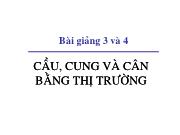 Kinh tế vi mô - Bài giảng 3 và 4: Cầu, cung và cân bằng thị trường
Kinh tế vi mô - Bài giảng 3 và 4: Cầu, cung và cân bằng thị trườngThị trường laø gì? Kinh teá thò tröôøng vaø kinh teá keá hoaïch taäp trung Caàu Cung Traïng thaùi caân baèng cuûa thò tröôøng Söï thay ñoåi traïng thaùi caân baèng thò tröôøng Thaëng dö tieâu duøng vaø thaëng dö saûn xuaát
 31 trang | Chia sẻ: thuychi16 | Ngày: 22/01/2019 | Lượt xem: 1282 | Lượt tải: 3
31 trang | Chia sẻ: thuychi16 | Ngày: 22/01/2019 | Lượt xem: 1282 | Lượt tải: 3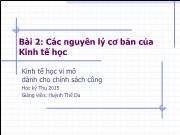 Kinh tế vi mô - Bài 2: Các nguyên lý cơ bản của kinh tế học
Kinh tế vi mô - Bài 2: Các nguyên lý cơ bản của kinh tế họcCon người phải đối mặt với sự đánh đổi 2. Mọi lựa chọn đều có chi phí cơ hội 3. Con người duy lý tư duy tại điểm cận biên 4. Con người phản ứng với các kích thích 5. Thương mại làm cho mọi người đều có lợi 6. Thị trường luôn là phương thức tốt để tổ chức các hoạt động kinh tế 7. Đôi khi Chính phủ có thể cải thiện được kết cục thị trường 8. ...
 12 trang | Chia sẻ: thuychi16 | Ngày: 22/01/2019 | Lượt xem: 1533 | Lượt tải: 3
12 trang | Chia sẻ: thuychi16 | Ngày: 22/01/2019 | Lượt xem: 1533 | Lượt tải: 3 Kinh tế vi mô - Bài 1: Giới thiệu kinh tế học vi mô dành cho chính sách công
Kinh tế vi mô - Bài 1: Giới thiệu kinh tế học vi mô dành cho chính sách công Con người sống vì gì? Tại sao bạn đi làm? Tạo sao bạn đi học? Cuộc thi: Ai là người quan trọng nhất trên hành tinh này? Mục tiêu của mỗi người khi đi làm là gì?
 20 trang | Chia sẻ: thuychi16 | Ngày: 22/01/2019 | Lượt xem: 1160 | Lượt tải: 3
20 trang | Chia sẻ: thuychi16 | Ngày: 22/01/2019 | Lượt xem: 1160 | Lượt tải: 3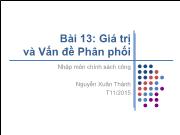 Nhập môn chính sách công - Bài 13: Giá trị và vấn đề phân phối
Nhập môn chính sách công - Bài 13: Giá trị và vấn đề phân phốiPhân tích kinh tế thực chứng để trả lời các câu hỏi: • Phân phối thu nhập và của cải tiến triển như thế nào trong dài hạn? • Liệu sự vận động của quá trình tích lũy tư bản sẽ chắc chắn dẫn đến sự tập trung của cải vào tay một số ít người? Hay các lực cân đối của tăng trưởng, cạnh tranh và đổi mới công nghệ ở giai đoạn sau của quá trình ...
 29 trang | Chia sẻ: thuychi16 | Ngày: 22/01/2019 | Lượt xem: 1394 | Lượt tải: 2
29 trang | Chia sẻ: thuychi16 | Ngày: 22/01/2019 | Lượt xem: 1394 | Lượt tải: 2 Nhập môn chính sách công - Bài 9: Thể chế
Nhập môn chính sách công - Bài 9: Thể chếThể chế chính trị “dung hợp”: Cho phép sự tham gia rộng rãi; hạn chế và kiểm soát các chính trị gia; thượng tôn pháp luật. Có một mức độ tập trung chính trị nhất định để có thể duy trì luật pháp và trật tự. • Thể chế kinh tế “dung hợp”: Quyền sở hữu được bảo đảm, luật pháp và trật tự, dựa vào thị trường, nhà nước hỗ trợ thị trường; gia nhập t...
 12 trang | Chia sẻ: thuychi16 | Ngày: 22/01/2019 | Lượt xem: 1354 | Lượt tải: 3
12 trang | Chia sẻ: thuychi16 | Ngày: 22/01/2019 | Lượt xem: 1354 | Lượt tải: 3 Nhập môn chính sách công - Bài 7: Thị trường và Nhà nước
Nhập môn chính sách công - Bài 7: Thị trường và Nhà nướcNhiều người bán, mỗi người bán một tỷ phần nhỏ của tổng sản lượng thị trường và không thể tác động đến giá. • Nhiều người mua, mỗi người không kiểm soát được giá. • Không có rào cản để nhà sản xuất tham gia hay rời bỏ thị trường. • Sản phẩn của các nhà sản xuất là đồng nhất và thay thế hoàn hảo cho nhau. • Thông tin hoàn hảo: nhà sản xuất và ...
 11 trang | Chia sẻ: thuychi16 | Ngày: 22/01/2019 | Lượt xem: 1295 | Lượt tải: 2
11 trang | Chia sẻ: thuychi16 | Ngày: 22/01/2019 | Lượt xem: 1295 | Lượt tải: 2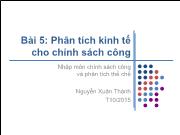 Nhập môn chính sách công và phân tích thể chế - Bài 5: Phân tích kinh tế cho chính sách công
Nhập môn chính sách công và phân tích thể chế - Bài 5: Phân tích kinh tế cho chính sách công“Lý thuyết kinh tế là khởi điểm hữu ích để phân tích tác động chính sách nhà nước bởi vì nó cung cấp một khuôn khổ để tư duy về các nhân tố có thể ảnh hưởng đến hành vi quan tâm”. Rosen và các tác giả (2014), Public Finance, Ch. 2 • “Một phần sự quyến rũ và lời hứa của kinh tế học là nó cho rằng có thể đưa ra được các chính sách giúp cải thi...
 7 trang | Chia sẻ: thuychi16 | Ngày: 22/01/2019 | Lượt xem: 1282 | Lượt tải: 3
7 trang | Chia sẻ: thuychi16 | Ngày: 22/01/2019 | Lượt xem: 1282 | Lượt tải: 3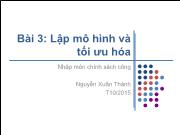 Nhập môn chính sách công - Bài 3: Lập mô hình và tối ưu hóa
Nhập môn chính sách công - Bài 3: Lập mô hình và tối ưu hóaMô hình là sự đơn giản hóa một khía cạnh nào đó của thế giới thực. • Các nhà phân tích chính sách công cần sử dụng mô hình bởi vì họ thường phải đưa ra các khuyến nghị chính sách trong bối cảnh có vô vàn các loại thông tin khác nhau. • Nhà phân tích phải loại bỏ các thông tin không cần thiết để vừa làm sáng tỏ vấn đề phân tích, vừa giúp xác...
 13 trang | Chia sẻ: thuychi16 | Ngày: 22/01/2019 | Lượt xem: 1229 | Lượt tải: 2
13 trang | Chia sẻ: thuychi16 | Ngày: 22/01/2019 | Lượt xem: 1229 | Lượt tải: 2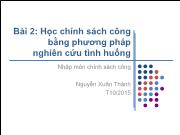 Nhập môn chính sách công - Bài 2: Học chính sách công bằng phương pháp nghiên cứu tình huống
Nhập môn chính sách công - Bài 2: Học chính sách công bằng phương pháp nghiên cứu tình huống• Nghiên cứu tình huống mô tả một tình huống thực tế mà ở đó một lãnh đạo, nhà quản lý hay chuyên gia phải đưa ra quyết định sau khi phân tích, xét đoán và cân nhắc dựa trên những thông tin sẵn có, nhưng không đầy đủ và thường lại mâu thuẫn nhau. • Nghiên cứu tình huống cung cấp thông tin, nhưng không có phân tích. Nhiệm vụ của học viên là ...
 11 trang | Chia sẻ: thuychi16 | Ngày: 22/01/2019 | Lượt xem: 1472 | Lượt tải: 2
11 trang | Chia sẻ: thuychi16 | Ngày: 22/01/2019 | Lượt xem: 1472 | Lượt tải: 2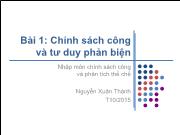 Nhập môn chính sách công và phân tích thể chế - Bài 1: Chính sách công và tư duy phản biện
Nhập môn chính sách công và phân tích thể chế - Bài 1: Chính sách công và tư duy phản biện• Chính sách công là hành động (hay không hành động) của nhà nước đối với các vấn đề của quốc gia hay vùng lãnh thổ • Vấn đề chính sách công xuất hiện khi xã hội không chấp nhận hiện trạng bất cập của một chính sách nào đó, và do vậy cần sự can thiệp (hay từ bỏ can thiệp) của nhà nước. – Thực trạng bất cập? – Cơ sở cho sự can thiệp của nhà ...
 10 trang | Chia sẻ: thuychi16 | Ngày: 22/01/2019 | Lượt xem: 1285 | Lượt tải: 2
10 trang | Chia sẻ: thuychi16 | Ngày: 22/01/2019 | Lượt xem: 1285 | Lượt tải: 2
Website đang trong thời gian thử nghiệm, chờ xin giấy phép của Bộ TT & TT.

